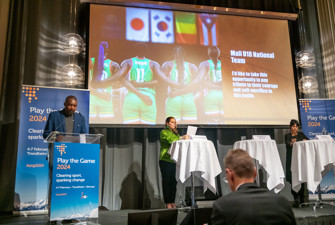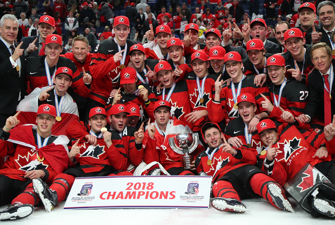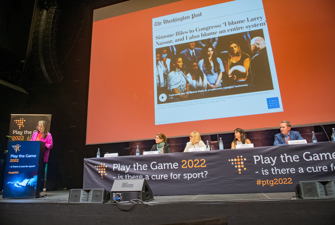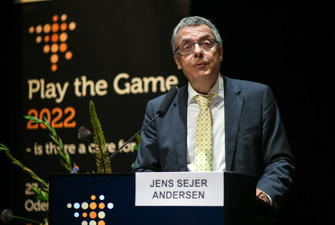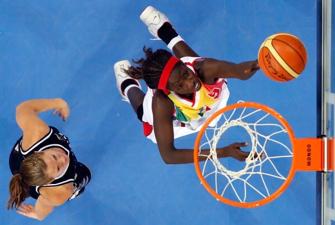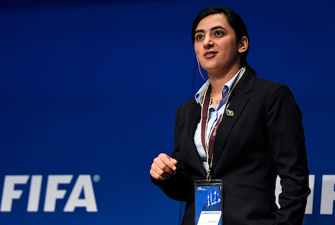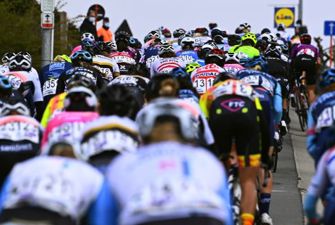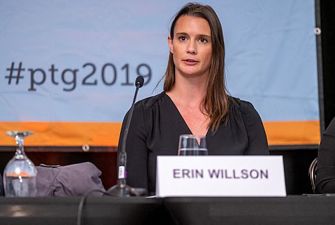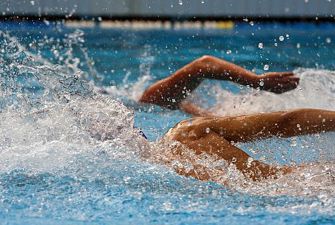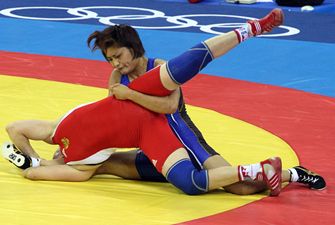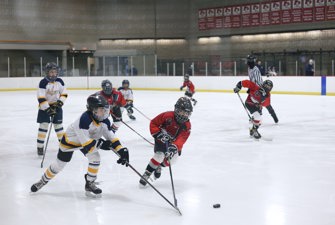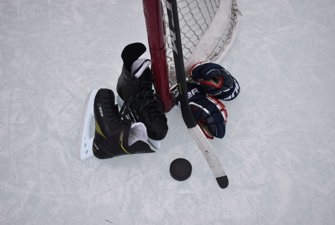Gods and Monsters - More Disturbing Stories about Hockey Violence against Women
In an assessment of women's role in hockey, Laura Robinson revisits some of the cases of sexual abuse from her book "Crossing the Line: Violence and Sexual Assault in Canada's National Sport". She also adds some very disturbing new stories about hockey players abusing girls as young as nine.
In January 1993 I traveled to Swift Current, Saskatchewan to investigate a disturbing report of a gang rape by two members of the Broncos. I contacted journalists who had covered the story and received the necessary background information, contacted the girl's lawyer and the investigating officer and ordered transcripts of the trial through the clerk's office. In 1989 the complainant had gone to the police upon the urging of a friend. She had talked about suicide in a serious manner and out of concern for her safety, the friend urged her to tell the police her story.
The Swift Current Broncos were very important people in this small town at that time. They had won the Memorial Cup in the spring of 1989 - the coveted championship cup of major junior hockey. When they returned from the championship, they were annointed as gods. They had, after all, lived out the first part of the Canadian Dream. The only part left for them now was to be drafted into the NHL.
Constructing a soft image of hockey players
No one mentioned it then or mentions it now, but girls cannot dream this dream. Not only are there no women in the NHL or the CHL, there was no hockey at all for girls or women in Swift Current - a situation that did not change until 2000. If girls wanted to live even a tiny slice of the Canadian dream they would have to do it vicariously through these boys and young men.
Broncos' management made this easy, not just for girls, but for all the citizens of Swift Current and surrounding area. Between the Broncos front office, the WHL, and the CHL, the team was marketed to perfection.
Players were happy to give autographs at McDonald's, Burger King, the Co-op Store, or the American giant box-store, Wal-Mart at the mall. As is the case with many pro male teams, the player events would frequently be couched as charity events with proceeds from the sale of french fries, hamburgers, hockey sticks or team booster items going towards a Good Cause.
Constructing a "soft" image of hockey players is very important as the violence they exhibit on ice must be balanced. This way images of broken teeth, concussions, and unadulterated fights will be tempered with players smiling as they sign pucks for little kids under a Ronald McDonald Children's Foundation banner. The local papers must, and do, put this image on their front pages, while the text beside it announces that the team helped raise $5,000.00 for families with children with cancer. They never could have done it without the great support they receive from the community. In other words, the team and the town are one big happy family.
Like the adults who go to the games, a certain amount of girls in Swift Current, and all other junior hockey towns believe the PR about the players. How wonderful to have a young man around who defends his territory on ice with aggression and wins the adulation of thousands for doing so, and then cuddles kids at Burger King and patiently signs their hockey stick. What a balanced and exciting young man. Yes, those fights on the ice seem terribly real. It is real blood that is spilled, real fists and power that slams into another player, but that's what young hockey players must do to win. It is rural Canada's construction of masculinity at work in the profit-making culture of the CHL.
And one does not have to worry about the violence. They leave all of that in the arena. As Marg and Ken Cobbe, two "hockey hounds" for the club who volunteered to raise funds in the local mall through lottery sales, told me in 1993 about the coach and players, "Graham James tries to make real gentlemen out of those boys. They're polite and well behaved. Winter without the Broncos would be empty…terrible."
The girl who went to the police about the alleged rape by Brian Sakic and Wade Smith, two Broncos players at the time, also believed on the night she invited Sakic over to watch TV that they were real gentlemen, polite, and well behaved. Like many teen-age girls in Swift Current, she thought they were terribly handsome and would love to have one as a boyfriend. After they left that night, she bled for two and a half days.
This case is chronicled in my book Crossing the Line: Violence and Sexual Assault in Canada's National Sport". Unfortunately, the publisher's legal counsel asked that all names of people and places that might identify the team and players be removed. I did not agree with this decision as the names and team were identified in the media (CBC Radio, CBC Television, as well as local radio and television, and the Regina Leader Post). They had been in the public domain.
The link from the James case to rape in Swift Current
Not only should they have been used in the book to give the story the journalistic integrity it deserved, but Crossing the Line also includes the Graham James-Sheldon Kennedy case. James pleaded guilty to 350 charges of sexual abuse after Kennedy and another player went to the police. The two stories showed the ugly cycle of sexual violence that was occurring in Swift Current. We know that victims of sexual abuse, particularly male victims, are at a much greater risk of becoming victimizers.
I believe there is a real link between what happened to the players on the Broncos team under James (though two players came forward, police believe between twenty and one hundred players were abused), and the sexual abuse of girls by Swift Current players.
I believe the denial of officials within the Broncos, the WHL, and the CHL in terms of their knowledge of Jame's abusive behaviour would have looked even more transparent had the 1989 alleged rape case been revealed as having also happened in Swift Current. It is very unfortunate that even a publisher would choose not to tell the whole story in hockey.
The Swift Current case was particularly troublesome. The guidance counselor at the girl's high-school, Colleen McBean, was the wife of the major owner of the team, Frank (Digger) McBean. She called the complainant into her office and told her that these were nice boys who would never do this and she should drop the charges. The complainant refused to do so. (The McBeans were also the billeting family for Sheldon Kennedy and say they had no idea he was being sexually abused by Graham James though he used to get off their phone in tears after speaking with James. Later Ms. McBean did not help one of the students who came to her after her Bronco boyfriend beat her up one too many times).
The RCMP officer, who had training in investigating sexual assault cases was taken off the investigation and an interrogator, with little training in sexual assault was assigned the case. The complainant was taken into a room at the police station, with no counsel or parents, and interrogated. Over two hours later, the complainant, who was also learning disabled, said maybe she hadn't said "no." Immediately public mischief charges were laid against her, and her name appeared in the media and news spread around the school. She was taunted, ostracized, and ridiculed endlessly. Brian Sakic and Wade Smith were traded to a west coast team and had the rape charges stayed against them. It was the girl who would now go to trial.
The trial clearly showed she had not consented to the violence and humiliation the players visited upon her. They penetrated her in all three orifices and taunted her. As he left her parent's apartment that night, Sakic hurled more abuse at her. The judge wrote that the players had, "ravaged her body for their own sexual gratification….She honestly believed she had said no."
While public opinion was strongly against the complainant before the trial, as evidence was presented during the trial, people started to change their minds. Sakic and Smith did not deny that they had done all the violent things she said they had done to her. The only difference between the complainant's story and the players' was that she said she had begged them to stop while they said she had begged for more.
How could Swift Current's young gods behaved in such a fashion? How could the same swell guys who sign hockey sticks for their sons be the same guys who made a teen-age girl to place her body in such a way so one of them could watch while the other penetrated her anally?
There was a long ovation for the girl when the judge handed down his decision. People assumed now that the rape charges would be laid once more and the players would be tried. Instead the charges were dropped and the players stayed with their new and remote teams.
I spent the next three years trying to determine if Swift Current was a particularly sick place or if this behaviour took place in other junior hockey towns. Unfortunately, I found that both scenarios were true.
As we would learn in 1997 when Sheldon Kennedy came forward with the stories of his own sexual abuse at the hands of James, Swift Current was a sick place. But there was no shortage of stories from other junior hockey towns either. Crossing the Line and CBC Television's the fifth estate documentary "On Thin Ice" are the results of these investigations. While I investigated five other hockey teams for sexual assault cases against females, and countless teams for the sexual assault of players during initiations, I returned to the Swift Current story in 1997 after former player Darren McLean told CBC Radio that James had paid players $50.00 each to have sex with girls as he secretly videotaped them.
In the end I investigated ten stories including the original alleged rape in Swift Current. They ranged from group sexual harassment by players to gang rape, to one girl being beaten up by her boyfriend while the rest watched. It was this girl who went to Colleen McBean and did not receive help.
Not all the stories made it into Crossing the Line. One young woman was afraid that her ex-boyfriend would come back and kill her if he knew she had talked to me. She told me I could not publish her story. No charges were laid in or convictions won in other cases, and it would be legally difficult to publish accounts without these. After the book came out, one more Swift Current story came my way as well.
For this paper I re-visited some of the Swift Current cases, as well as another case I couldn't include in the book because no arrests had been made, nor had there been an investigation by police.
In the spring of 2004, I spoke with Murray Walter, the Swift Current lawyer who represented the complainant in the 1989 alleged rape. Since 1998, when Crossing the Line came out, I had periodically spoken with him about developments in the Graham James case. On each occasion I asked if his client would like to speak to me about how she feels now.
When I arrived in Swift Current, nearly four years after the alleged rape had occurred, she was just getting out of counseling, and though she thought it was important to write about these issues, she was not able to talk to me about the night in 1989. This was her response each time I conveyed my wishes to interview her through her lawyer.
This year was no different as Murray Walter explained to me that his former client, "wanted to leave this behind her. Whether rightly or wrongly, she thinks this will go away if she doesn't talk about it."
I then asked Murray Walter if he felt girls and young women were safer now that the sexual abuse of the players had been officially addressed with the Player's First policy of the CHL.
Walter felt nothing had changed. "I don't go to hockey games and I don't follow the team. I got kind of disgusted with junior hockey. I don't think it reflects the things that are good about us. It has a real dark side."
Victim of hockey rape turned coach
There was, however, another young woman who would talk about how she feels today about the rape she endured in her teens at the hands of a WHL player. I cannot reveal the town she lived in or lives in now, but I contacted her in the winter of 1999-2000 after a disturbing event occurred at the CHL press conference in Calgary on December 6, 1999 where they announced that Regina had won the right to host the Memorial Cup.
December 6 is also the anniversary of the Montreal Massacre at Ecole Polytechnic. I attended that press conference and asked Commissioner Dev Deley if he felt it was appropriate to hold a press conference for a sport that many Canadians believe teach boys and young men how to be violent on a national day of mourning for women who have had violent acts committed against them.
Deley became very angry, told me he would not answer the question and walked away. I followed as he walked into a boardroom where it looked like a CHL meeting was about to take place. We had a tug of war with the door as he tried to shut it and I tried to keep it open. I shoved my foot into the door frame. Deley told me if I wanted questions answered I would have to call the league's lawyer, Aaron Fox, in Regina. Finally I relented, let the door go, and did, in fact, call Fox.
Aaron Fox has most recently been in the news because of his role in the Neil Stonechild Inquiry in Saskatoon. The Inquiry looked into the death of 17-year-old Neil Stonechild, a First Nations boy who was last seen alive in November 1990 in the back of a police vehicle. His frozen body was later found in a field near Saskatoon. The police say they have no idea how Stonechild got to the field, and have no records of him being in the custody of police officers that night. Constable Larry Hartwig, also known as "Redneck" was one of the officers identified as forcing Stonechild into his vehicle. The constable is being represented by Aaron Fox at the Inquiry.
I asked Fox the same question I had asked Deley about the timing of the press conference, and he too became angry as he told me he felt women hockey players would take offense at me imagining such a thing. Hockey treats men and women equally Fox stated.
Did women have equal access to ice in Regina? I asked. Of course they did, he stated. I thanked Fox and called to the University of Regina where one of the kinesiology professors directed me to a female hockey player - not from the university, but someone who played in town.
She laughed when I asked her about equal ice-time. "Are you kidding," she said. "We're a [top ranked team] and bantam boys get ice-time over us. We train at the RCMP barracks outside of town. The ice is in terrible shape, it's dark and late at night. We don't get anything close to equal ice-time."
I told her why I had called Fox in the first place and she replied, "You wrote Crossing the Line, didn't you?" I told her I had. "I can tell you about hockey players and violence against women. My boyfriend played for the Swift Current Broncos and he raped me. He also raped another girl, and tried to rape another girl but she got away."
Her way of working out the pain and trauma of the experience she said was to make things better in hockey for the next generation of girls. Since then she has become a hockey coach and started a hockey program in her hometown that hadn't had any hockey whatsoever for girls previously. "Hopefully they will be interested in playing hockey and won't fall for all that PR about the players," she said.
In the winter of 2004 I contacted this woman again. She agreed to talk about her experiences then and now. When she grew up, her town had no hockey for girls. The odd girl would be allowed to play on the boy's team, but every time those girls excelled against boys it "did not go over well with the parents. They didn't like girls beating boys."
Her parents put her in ringette when it started, but after Saskatchewan won the right to host the Canada Winter Games when she was fourteen, there were hockey practices organized by the province for girls to attend. When her parents moved to a larger city, she joined a women's league at age nineteen that played against midget boys and junior and bantam girls.
Her senior women's team excelled, and eventually she returned to her hometown and started a hockey program for girls. In 2000 they formed a girl's division in the minor hockey association. Today they have girl's teams from Initiation up, with at least one team in midget every year. The teams are very competitive and others have started to coach.
The drawback, she states, is that few women coach. She believes girls need women as role-models and hockey needs the input of women as much as possible. Still though, if a place like Swift Current had equal amounts of ice-time for females, she believes junior hockey players would still be dangerous. "I think it's hockey that teaches them violence and I think it's the community that puts them on a pedestal. It hasn't really changed (since Graham James was convicted). They are all still kings."
When she looks back on the behaviour of her former boyfriend from the Broncos, she says she'll never know if he was one of James's victims. "He went nuts one night at the bar," she remembers. "When I met him he wasn't really a drinker. But he was so angry that night he kicked the windows of a police vehicle out. He was traded shortly after that. "
"I also feel like I did kind of know about Graham. There was talk amongst the younger players that he would get into the shower with them. He was being made fun of by the players (because they thought he was gay). If I kind of knew, how could they (Broncos' management) not know?"
"Graham was very intelligent. He was such a charmer. But if they ever followed up on all of this it would have ruined their game and none of those people were going to let that happen."
In terms of her own situation, she said she was a victim of date rape. "It was only after a few years after that that I could really tell myself what happened. But you always know in your gut. You're sick about it. "
"Looking back I realize that I should have had more counseling. At the time I really got into hockey instead. I was gone every weekend playing and was too busy to drink or get into trouble. I wasn't really into the crowd that hung with hockey players in the first place, and after I broke up with him, I didn't see that crowd so much."
"Experiences - good or bad - make you who you are. I don't think I'd be as strong as I am today if it hadn't happened. I don't think players should have nearly as much power. There's a lot of denial still in that community."
Hockey-raped at the age of nine
The next young woman I interviewed this winter is also anonymous.
I first spoke with her when I was researching for Crossing the Line from 1993-1998. A police officer, who was aware of my investigation, in a large Canadian city, told me that she had phoned the Crime Stoppers line. I did not include this case in Crossing the Line because, like other cases that didn't have charges laid or convictions, it would not stand up to legal scrutiny. A story may be true, but before one writes anything in a negative sense about professional athletes in North America, there has to be an airtight case against them with a significant amount of evidence.
As I stated above, even when you have all the evidence, as I did in the Sakic and Smith case, lawyers can kill a large part of your story. Perhaps publisher's lawyers have the well being of hockey at interest over journalistic integrity.
What is important to remember about this case is that the girl phoned the police before the Sheldon Kennedy case was public. In other words, this was not a case of someone wanting to imitate Kennedy and have the public adulation the way he had.
This girl at age nine was introduced to rape at the hands of hockey players by her mother, a scout for a CHL team. She remembers being dressed up in a black miniskirt and her mother putting make-up on her. "I thought we were playing dress-up," she said.
Instead, she was made to drink a great deal of alcohol and taken to a hotel where hockey players were staying during a large tournament. The man who organized the child sex ring she says, told her five years later that he first had sex with his mother at age five. She says she and other children - mainly girls - were given to various hockey players who sexually assaulted them.
"The unstoppable liquor kills the pain" she said of those days that lasted until she was fourteen and her mother committed suicide.
Giving one's daughter to young men to rape and suicide were only part of the family's dysfunction. It was a blended family to begin with as children came from two different families to form the one she grew up in. Her mother left the family with her when she was nine and her father later pleaded guilty to sexually abusing her brother.
This girl later moved in with her grandmother. When she gathered the strength as an older teen-ager, she told her grandmother, who told one of her sister's what had happened. She says her sister's response was to "burst into my room and say, 'That never happened to me. I never would have allowed it.'
"All my life I don't expect people to own up to the truth,'" she says. "But they know the truth, I know the truth - we both know it. My other sister stopped talking to me. She's been in and out of mental health facilities. She has a mental illness."
To cope later on, she says "you get into this motion in life where you stop dealing with it. I still have issues every day. I'm more suspicious of women than of men. I just saw too many mothers offering their kids up. I used to experience rape crisis syndrome every day until four years ago when I was seventeen. Michelle, my counselor, helped me through, but I used to get really bad vaginal cramping. I couldn't walk or sit. Now it only seems to happen monthly."
"I was told since I was a little kid that the baseball and hockey boys were just so great, but I experienced the opposite. Today I feel I have a major depression over hockey. If I know there is even a hockey game on at this arena I feel sick. If hockey players come into the store (where she works), I stay in the back room. I don't like sports bars because they play hockey games on TV. There's a huge control issue, it's so abusive, even on the ice, physically and verbally. I think it attracts (people like the man who started the sex ring for the players). It becomes its own society."
Later I received an email from her entitled, "Gods and Monsters." In it she says that one day she asked the man who started the sex ring "WHY?"
"His response," she writes: "The guys who like the young ones are needing it for the innocence that they intend to steal. Drafted too young, away from Mommy, the teams they are up against are too aggressive."
"The guys who just use prostitutes or drugs, alcohol or all of the above, they are trying to fit in; trying to be a member. Must of happened young…their exposure to those scenes. Yet, you have to understand, it's a social status."
She continued to explain in her own words: "It's a God given right that turns the nicest farm boy into a monster. You almost want to compare it to the last of the 'societies' conquered by women's suffrage. Yet in these man's minds, you are the one with the power. You're the one that made them do it. Just by being pretty, by being seductive (?), just by being there. I guess drugs and alcohol make the whole scene bearable, if you're intoxicated and your other 'team' player is too, who can remember, who can fight, who fucking cares? If you, as a woman, are unable to protect yourself with a sound mind, let alone a sane one, what judge, jury or even next door neighbour are gonna believe you? What do you mean you didn't enjoy it? What do you mean you weren't really looking for it?"
"My mind can't handle the Kobe case. I turn the station and feel like shit for the remaining day. I blame everyone involved, including Grandma, for my inability to finish. But I'm the one in the mirror at night, and there are days I can't stomach what I see."
"The drugs and the alcohol make everything blurry, you can't see a thing. Does it matter what happened last night? You are who you are. Who are they?"
This young woman also wrote about her bulimia and told me, while she cried, that she felt ruined. She said that her sister can't imagine why she doesn't want to have sex. "It's not there," she told me. "as far as I am concerned, I'm asexual."
This young woman spoke to me over at least two years during the writing of Crossing the Line. Her stories were consistent and did not contradict one another during that time. Still, I was resistant to believing her.
Two years later I was in the city she said the sex ring took place in. A therapist who works mainly with teen-age girls on eating disorders and sexual abuse told me she wanted to open a centre for teen-age prostitutes and approached the police on the vice squad for assistance. She suggested to them that they approach the professional teams in the city on fund-raising projects.
The police told her that wouldn't be possible because the teams were the biggest users of the girls. She asked them why they didn't arrest the players and was told professional athletes don't get arrested for things like this. That same year, in the same city I was a judge on children's essays on violence, along with another woman who worked in that field. She told me she had had a job on the front desk of a major hotel during the night shift but had to resign because she couldn't stand to see so many hockey players bringing girls to their rooms.
Around the same time a high-ranking RCMP officer in another province told me that some of his colleagues in vice eventually became the people they were supposed to arrest. I did not seek any of these stories out, nor did I give these individuals any information from the girl. Her stories in 2004 were as consistent as they were in 1997-98.
Evidence of abuse emerges in many places
If we did not already know about the Graham James case and the Maple Leaf Gardens sex ring of boys, people would be able to write this off as a young woman with a demented imagination. If we did not know about the flood of calls to rape crisis centers by both women and men after Kennedy came forward about the abuse he suffered, we may be able to say this story is just bad fiction. If we did not know that a circus will start soon in the United States when the Kobe Bryant rape trial commences, those who say professional male sport is just another form of entertainment might be able to get away with that viewpoint.
But we can't claim hysteria, fiction, rape fantasy, or anything else today and we can't claim that violent sports are mere entertainment. While on the plane to the Maritimes I sat beside a woman. We shared with each other why we were on the flight. I told her I was attending two hockey conferences, and told her what I was speaking about. She replied, "I think with hockey teams rape is common."
I was quiet and then asked her why she thought that. She looked straight at me and said, "I'd rather not say" and turned red. She added that she felt women should be honest about sexual assault since it happened to virtually all of us.
During the trip from Fredericton (where I attended another hockey conference) to Halifax, I bought the local paper, The Times and Transcript, outside of Moncton. The front page on March 25, 2004 carried the story, "Repeat Child Molester Sent to His Room." Paul Cormier, now fifty-eight, but a coach of boy's hockey in the 1970's and 80's, was convicted of sexually assaulting his paperboy in 1974 and '75.
Previous to this he had been convicted on a series of assaults including sexual assault, indecent assault, sexual interference, gross indecency and invitation to sexual touching, against young hockey players. He had successfully coached the Decker Boy Beavers to the New Brunswick Junior 'A' hockey championships in 1980 and 1981. In 1982 and 1983 he also coached the Moncton Midland Hawks to the Maritime Junior 'A' Championships.
In Friday's Globe and Mail, the sports section reports that the complainant in the Kobe Bryant sexual assault case has asked for the trial to occur in the near future. Her lawyer, John Clune, said she has been, "forced to quit school, she cannot live at home, she cannot talk to her friends, and she has received literally hundreds of phone calls and e-mails threatening either death or mutilation."
"She has lived in four states in the past six months," says her mother and she and her husband are "constantly worried about her safety. "She can't live at home, she can't live with relatives, she can't go to school or talkj to her friends," she continued. "Even the defendant is able to continue living in his home and continue his employment."
The complainant asks, "When will the media or defense investigators find me and where will I go then?"
The same day, the Globe reported that another woman has come forward with sexual assault allegations against the University of Colorado football team in Boulder. She is the eighth woman to speak to the police about the sexual assaults she said she endured at the football player's hands.
Last October when I was preparing to speak on this subject to the Finnish Investigative Journalist's Association, I did a one-week search of the Globe and Mail's sport section. There were thirteen articles about sexual assault in sport that week.
I do not believe there is any real investigative journalism in the sports media. Nor is there any understanding, or perhaps it would be more correct to say, intentional misunderstanding, of how these issues are connected. I did not find it difficult to find these young women or to test to see whether or not their stories stood up to scrutiny. At this point I tend to believe the girl who first called Crime Stoppers.
The sports media is very much like the CHL lawyer Aaron Fox, who wants to believe there is no connection between the intentional violence in junior hockey and the violence those players commit against women. This is because he denies that they commit any acts of violence against women, and that women enjoy equality in his favorite sport.
But like the Stonechild Inquiry that took place fourteen years after the fact, the story of sexual assault in hockey will be with us for a long time. In April 2003 the Ontario Court of Appeal ruled that intergenerational victims of residential school had the right to sue churches and government. What this decision recognized was the unfortunate ripple affect of abuse. Just because someone didn't attend residential school doesn't mean they didn't become victim to the abuse perpetrated there as those that did attend so often became abusers.
To follow this argument, girls and young women who were victims of players in Swift Current, who were themselves victims of Graham James should have the same legal right to sue. When we present a paper on a topic or written a book, it appears as if the story has a beginning, middle, and end. But stories continue to play out when we have finished telling the little slice of them we tell. I hope that the next generation of women hockey players, journalists, and academics continue to tell the real story of hockey night in Canada so one day we will have a more accurate picture of this nation's obsession.


